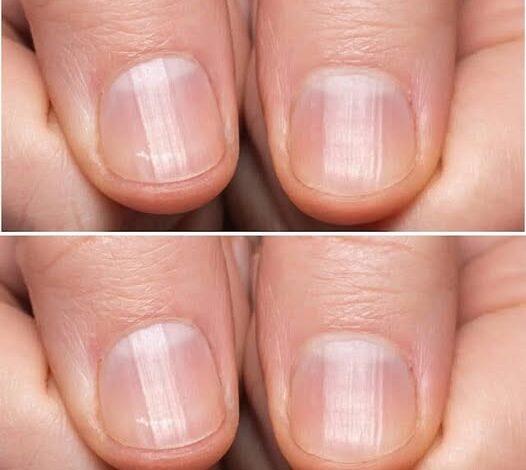
Having Striped Nails Could Mean That Your Body is!
Your nails can reveal more about your health than you might realize. Stripes, ridges, or lines on fingernails and toenails often appear harmless at first glance, but they can sometimes signal underlying health concerns. Paying attention to these subtle changes can help you catch issues early and make the necessary adjustments to improve your overall well-being.
Striped nails come in different forms, ranging from fine vertical ridges to deeper horizontal grooves, or even white or dark streaks. Each variation has its own potential causes, from normal aging to nutrient deficiencies and even more serious health conditions. Understanding what these signs might mean can give you the tools to take better care of your nails and your body.
Vertical ridges are among the most common nail changes. These fine, parallel lines run from the base of the nail to the tip. For many people, they are a natural part of the aging process. As we get older, nail growth slows down and becomes less even, leading to these harmless ridges. Mild dehydration can also contribute to their appearance, as can deficiencies in nutrients like biotin, iron, or zinc. While usually not serious, vertical ridges can be minimized by staying hydrated, eating a nutrient-rich diet, and taking supplements if recommended by a doctor. Buffing the nails gently can also help smooth them out, but it’s important not to overdo it to avoid thinning the nail plate.
Horizontal ridges, also called Beau’s lines, are different and often more concerning. Unlike vertical ridges, these grooves run across the nail plate and usually indicate a disruption in nail growth. They often appear after significant stress on the body, such as severe illness, surgery, or high fever. Nutritional deficiencies, particularly in protein, zinc, or iron, can also contribute. In some cases, Beau’s lines are associated with thyroid problems, diabetes, or circulatory issues. If you notice horizontal ridges, it’s best to consult a healthcare professional. They can determine whether the cause is temporary or linked to an underlying condition. Supporting recovery with a nutrient-rich diet and keeping nails hydrated will also help as they grow out.
White stripes or spots on nails, known as leukonychia, are another common occurrence. They are often caused by minor trauma to the nail bed or deficiencies in essential nutrients like zinc and protein. Occasionally, persistent white streaks may point to liver or kidney issues. If you notice these spots, adding zinc-rich foods such as pumpkin seeds, seafood, and legumes, along with lean proteins like eggs or chicken, can be beneficial. If the marks do not improve, your doctor may recommend blood tests to rule out more serious causes.
Dark stripes or discoloration on nails require immediate medical attention. A condition called melanonychia, which results from increased melanin in the nail, may cause dark vertical stripes. While this is sometimes benign, it can also indicate a rare but serious form of skin cancer called nail melanoma. Early detection is critical for effective treatment, so any new or changing dark stripe should be evaluated by a dermatologist as soon as possible. Warning signs include changes in the stripe’s width, irregular edges, or spreading color.
Brittle or grooved nails with stripes can sometimes point to hormonal or thyroid imbalances. Hypothyroidism, or an underactive thyroid, is a common cause of weak nails with ridges. Hormonal changes during pregnancy or menopause can also affect nail health, making them more prone to breakage and irregular growth. If these nail symptoms occur alongside fatigue, hair loss, or unexplained weight changes, it is important to ask your doctor for a thyroid function test. Managing hormonal health with proper medical care, diet, and stress management can help restore nail strength over time.
Even when nail stripes are harmless, maintaining strong and healthy nails should be a priority. Simple daily habits make a significant difference. Moisturizing nails and cuticles with oils or creams prevents dryness and brittleness. Wearing gloves while cleaning or using harsh chemicals protects the nail surface from damage. A balanced diet rich in biotin, iron, zinc, and omega-3 fatty acids provides the nutrients your nails need to grow strong and smooth. Hydration is equally important, so drinking plenty of water helps keep nails flexible and less prone to splitting. Monitoring nail changes and seeking medical advice when symptoms worsen or persist ensures that potential problems are caught early.
Knowing when to see a doctor is crucial. If your striped nails are accompanied by other symptoms such as fatigue, skin changes, pain, or swelling, it is best not to ignore them. Persistent discoloration, sudden new stripes, or dark streaks should always be evaluated promptly. A healthcare professional can conduct examinations and tests to rule out systemic illnesses, nutrient deficiencies, or more serious conditions.
Striped nails are often just a natural part of life, especially with age. However, they can also serve as early warning signs of deeper issues. Vertical ridges are usually harmless, while horizontal grooves, white marks, or dark discoloration may indicate nutritional imbalances, health conditions, or in rare cases, cancer. By staying aware of these changes and supporting nail health through hydration, nutrition, and care, you can keep your nails strong and healthy while protecting your overall well-being.
Your nails are more than just cosmetic—they are small but powerful indicators of your body’s health. Paying attention to the subtle messages they send allows you to take proactive steps in maintaining both nail strength and overall wellness. If you ever feel uncertain about changes in your nails, trust your instincts and consult a doctor.
Have you noticed stripes or ridges on your nails before? What steps did you take to address them? Share your experiences and tips for healthier nails in the comments below.




